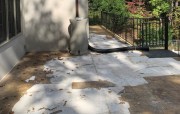Across the U.S. there are many sources of aggregate, but in some areas the best aggregates are depleted or nearly so, and concrete producers are being forced to use aggregate that may be reactive and lead to alkali-silica reaction (ASR) in the concrete. ASR is destroying highways and runways across America. This problem is most worrisome with pavements and that may be especially true with pavements that are exposed to deicing salts. State DOTs and airport authorities are reacting by demanding proof that the aggregate in their concrete will not lead to ASR—more about that in a minute.
There are a few ways to deal with, or mitigate, the potential for ASR, but the most common and affordable way is with fly ash. Fly ash mitigates ASR by binding with some of the alkalis in the cement, reducing the concrete permeability, and increasing its tensile strength. Historically, fly ash was almost free and readily available, but with the phasing out of coal-fired power plants due to cheap natural gas and increasingly stringent pollution controls, fly ash has become scarce in many parts of the country. This situation only promises to get worse, despite our new president’s promise to revive coal.
Providing evidence of aggregate reactivity and potential for ASR requires testing, but this is difficult and expensive. The most reliable test, ASTM C1293, Standard Test Method for Determination of Length Change of Concrete Due to Alkali-Silica Reaction, takes one year to complete. Other faster tests are not reliable. Now, a new test, the autoclaved concrete prism test (ACPT), is showing promise for much quicker results in as little as a week. Jennifer Tanner at the University of Wyoming has shown good agreement between results obtained using C1293 and the ACPT. Identical tests have been run at the University of Alabama with close agreement, proving its repeatability. This test is still being developed, and isn’t yet an approved ASTM test method, but could provide a quick, easy way to characterize the reactivity of aggregates.
But what if there’s no fly ash available? One alternative is metakaolin, a clay that is burned in a kiln and then ground. This material is highly reactive and seems to do a good job mitigating ASR. To learn more about metakaolin, watch this short interview with Christopher Tull of CRT Concrete Consulting, who has worked with the material.


